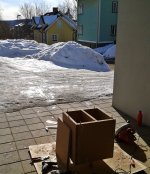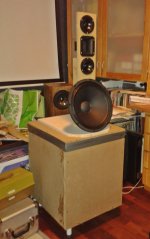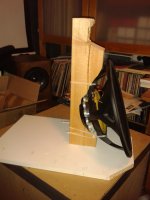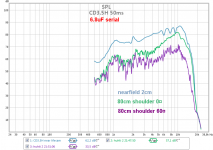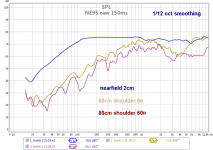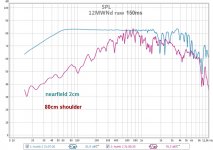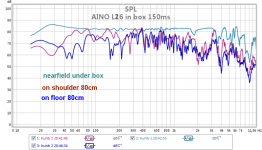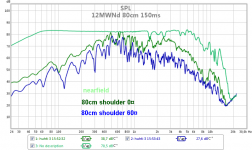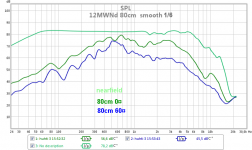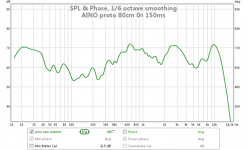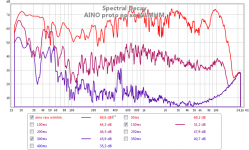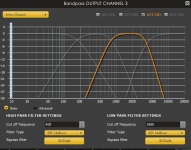My components are arriving!
I already have the high-mids and mono amplifiers. The minidsp, stereoamps and rest of drivers have landed in Finland. The Easter holidays are coming and we get all our children at home and some friends too - there will be minimal time and space for my hobby now. But right after that!!!
I have been considering the amp setup. I have 1 mono 170W and two 2x50W amps per side. Which drivers soak most power? The music has most of power at 50 - 2500Hz (consistently at 150-1000Hz). The sensitivity of Beyma 12" is good but it needs eq when used 200-1000Hz as a dipole. The L26ROY needs some eq too in a closed box - or a port (that I don't want). My listening levels are moderate, peaks never above 100dB, seldom even 93dBA
Well, I can easily plug the RCA-wires differently to amps because the minidsp takes care of eq and level. And I can get some more powerful icepower amps easily...
I have been thinking of putting the amps inside the bass boxes in the final AINOs, but test will be run "outboard"
I already have the high-mids and mono amplifiers. The minidsp, stereoamps and rest of drivers have landed in Finland. The Easter holidays are coming and we get all our children at home and some friends too - there will be minimal time and space for my hobby now. But right after that!!!
I have been considering the amp setup. I have 1 mono 170W and two 2x50W amps per side. Which drivers soak most power? The music has most of power at 50 - 2500Hz (consistently at 150-1000Hz). The sensitivity of Beyma 12" is good but it needs eq when used 200-1000Hz as a dipole. The L26ROY needs some eq too in a closed box - or a port (that I don't want). My listening levels are moderate, peaks never above 100dB, seldom even 93dBA
Well, I can easily plug the RCA-wires differently to amps because the minidsp takes care of eq and level. And I can get some more powerful icepower amps easily...
I have been thinking of putting the amps inside the bass boxes in the final AINOs, but test will be run "outboard"
Yesterday I installed a test bed for the high-mids and a tweeter in MTM. I expect to get the ninidsp and U-MIK today...
John Reekie has done a wonderful writeup of how to set up a 4-way system using minidsp here at hifizine.com. His speaker had a dipole woofer, I am going monopole up to 150-200Hz whre room modes deteriorate soundwaves and localization anyway (at my listening distance)
I'll make a proto box/setup for AINO in a few days and I can start making measurements after Easter. I plan to make a turntable between W and MMTM sections to help me getting off-axis measurements. Jon Marsh has used 30¤ off-axis measurements as major guideline when setting up his Isiris, which is a conventional monopole. I have followed his projects for many years and I have high respect for his achievements.
John Reekie has done a wonderful writeup of how to set up a 4-way system using minidsp here at hifizine.com. His speaker had a dipole woofer, I am going monopole up to 150-200Hz whre room modes deteriorate soundwaves and localization anyway (at my listening distance)
I'll make a proto box/setup for AINO in a few days and I can start making measurements after Easter. I plan to make a turntable between W and MMTM sections to help me getting off-axis measurements. Jon Marsh has used 30¤ off-axis measurements as major guideline when setting up his Isiris, which is a conventional monopole. I have followed his projects for many years and I have high respect for his achievements.
The test mule version of AINO has been constructed!
The box is too big but I had some 50cm sheets left - 76 liters. The final version will be roughly 40 L. The final version will also have a more tighty set met-section, also flush-mounted and even more chamfered holes
The turntable holds the Beyma 12" and tweeters. I marked 15, 30, 45, 60 and 90¤ angles to it. The wiring will be done tonight too.
The box is too big but I had some 50cm sheets left - 76 liters. The final version will be roughly 40 L. The final version will also have a more tighty set met-section, also flush-mounted and even more chamfered holes
The turntable holds the Beyma 12" and tweeters. I marked 15, 30, 45, 60 and 90¤ angles to it. The wiring will be done tonight too.
Attachments
Thank You for the encouragement, lolo!
I have listened to the raw drivers. The SEAS L26 is an amazing thing! It plays very high and has a very solid bass in my downfiring box, without any eq. The Beyma sounds good too and the dipole effect sounds stronger than L26 when held and twisted around in my hands!
I ordered a pair of B&O 125ASX modules yesterday. They deliver 2x125W which sould be enough for SEAS and Beyma. This way there will be two B&O modules per box.
I have listened to the raw drivers. The SEAS L26 is an amazing thing! It plays very high and has a very solid bass in my downfiring box, without any eq. The Beyma sounds good too and the dipole effect sounds stronger than L26 when held and twisted around in my hands!
I ordered a pair of B&O 125ASX modules yesterday. They deliver 2x125W which sould be enough for SEAS and Beyma. This way there will be two B&O modules per box.
Last edited:
My first measurements!
I used a Microsoft LifeCam 3000HD usb-camera's microphone! It is rather good actually! The environment is not good, this was just a sanity check!! REW sweeps 256 or 512kb, levels adjusted a little between nearfield and 80cm!
Seems to match my simulations quite well. The HM baffle should be even narrower, as close to 100mm as I can.
L26 measures like magic! No smoothing
12MWNd shows cavity resonance at 2kHz and the dipole response. No smoothing
NE95 pair is ok, dipole response ok. Nearfield is from only one driver and 1/12 smoothing was used on all these graphs
CD3.5H shows lots of resonances/reflections/diffractions, 50ms gate, no smoothing. A 6.8uF serial capacitor was used for protection.
I can sum this as: It's easy to cross between W, LM and HM. Hm to T must be steep LR4 or LR6
I used a Microsoft LifeCam 3000HD usb-camera's microphone! It is rather good actually! The environment is not good, this was just a sanity check!! REW sweeps 256 or 512kb, levels adjusted a little between nearfield and 80cm!
Seems to match my simulations quite well. The HM baffle should be even narrower, as close to 100mm as I can.
L26 measures like magic! No smoothing
12MWNd shows cavity resonance at 2kHz and the dipole response. No smoothing
NE95 pair is ok, dipole response ok. Nearfield is from only one driver and 1/12 smoothing was used on all these graphs
CD3.5H shows lots of resonances/reflections/diffractions, 50ms gate, no smoothing. A 6.8uF serial capacitor was used for protection.
I can sum this as: It's easy to cross between W, LM and HM. Hm to T must be steep LR4 or LR6
Attachments
Last edited:
I have a calibrated U-MIK from minidsp coming to me, but obviously the Easter holidays have made a delay to the delivery. They were cleared at the Finnish customs a week ago!
The raggedness in the curves comes mainly from the room. We must look at the "big picture" now. I think I will do outdoor ("anechoid") mesurements too when the weather and songbirds allows that
The raggedness in the curves comes mainly from the room. We must look at the "big picture" now. I think I will do outdoor ("anechoid") mesurements too when the weather and songbirds allows that

Last edited:
By the way I'm wondering if AINO will have too much directivity to my taste!?
a lot of people would like to have that problem, I think..
ScottG, appreciated! Please follow my measurements and give more comments as I progress.
Here are the 0¤/60¤ measurements of Beyma 12"
MSLifeCam, REW 150ms, 512kb
The 60¤ shows quite consistently 6-10dB reduction of spl for both Beyma and Vifa - good news! Also easy to match to NeoCD3.5 (directivity-wise)
Here are the 0¤/60¤ measurements of Beyma 12"
MSLifeCam, REW 150ms, 512kb
The 60¤ shows quite consistently 6-10dB reduction of spl for both Beyma and Vifa - good news! Also easy to match to NeoCD3.5 (directivity-wise)
Attachments
Last edited:
ScottG, appreciated! Please follow my measurements and give more comments as I progress.
Here are the 0¤/60¤ measurements of Beyma 12"
MSLifeCam, REW 150ms, 512kb
The 60¤ shows quite consistently 6-10dB reduction of spl for both Beyma and Vifa - good news! Also easy to match to NeoCD3.5 (directivity-wise)
I could be wrong, but I think you are getting to much gain from the rear of the 12" from the loading on top of the bottom cabinet (or the white bass-board you have to stabilize the 12" on the top of the bottom cabinet).
I'd try raising-up the 12" driver about 4" from its base and use about 3" of Rockwool on that base (with a 1" air-gap between Rockwool pad and bottom of 12" driver).
That should give a more uniform response in that 400-800 Hz range.
Otherwise everything else looks pretty good so far.
I particularly like the use of the minidsp - a very wise decision for a project like this (..both for performance and value).
Last edited:
ScottG ... I think that response is fairly typical of a naked 12" driver. Juhazi will most likely need a 4.0 Q notch of around 4db @720hz or so to get it balanced.I could be wrong, but I think you are getting to much gain from the rear of the 12" from the loading on top of the bottom cabinet (or the white bass-board you have to stabilize the 12" on the top of the bottom cabinet).
I'd try raising-up the 12" driver about 4" from its base and use about 3" of Rockwool on that base (with a 1" air-gap between Rockwool pad and bottom of 12" driver).
That should give a more uniform response in that 400-800 Hz range.
Otherwise everything else looks pretty good so far.
I particularly like the use of the minidsp - a very wise decision for a project like this (..both for performance and value).
Puppet,
how could a notch filter take care of a notch in direct response and a hump at 550Hz in 60¤ response? Notice that this is a typical dipole response if we disregard the small irregularities. Minidsp takes care of "straightening" the dipole-curve.
When I get the calibrated mic I'll make new measurements and try to find out what causes this. It is at a very "popular" frequency! Matt treatment is easy, lifting the driver makes the final speaker taller. The final speaker will have a round "table" under the 12" driver, without a separate turntable board.
It was quite tricky to get a "good-looking" nearfield response from the 12". It makes such a big cavity with lots of resonances
The FedEx tracking showed that U-MIK and miniDSP delivery was tried at 2. April. I contacted them by phone and now they promised a new delivery for tomorrow. They are a very small "player" here and service is bad.
how could a notch filter take care of a notch in direct response and a hump at 550Hz in 60¤ response? Notice that this is a typical dipole response if we disregard the small irregularities. Minidsp takes care of "straightening" the dipole-curve.
When I get the calibrated mic I'll make new measurements and try to find out what causes this. It is at a very "popular" frequency! Matt treatment is easy, lifting the driver makes the final speaker taller. The final speaker will have a round "table" under the 12" driver, without a separate turntable board.
It was quite tricky to get a "good-looking" nearfield response from the 12". It makes such a big cavity with lots of resonances
The FedEx tracking showed that U-MIK and miniDSP delivery was tried at 2. April. I contacted them by phone and now they promised a new delivery for tomorrow. They are a very small "player" here and service is bad.
Last edited:
Juhazi,
your measurement of the 15" driver follows the theory almost completely:
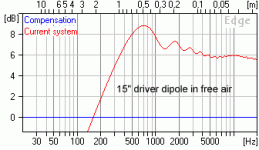
You see the dipole peak at ~700 Hz and the light dip at ~1.2 kHz. The "natural" thing to do would be applying a first order lowpass at 100 Hz. This will level out the rising response to the dipole peak and start a downward slope above the peak. A notch filter would always go along whith a phase wiggle and you don't want to have that if it is not necessary.
Let's not get too finicky about small response wiggles at different angles. You already see how the small dent in the 0° response could be compensated by the small peak in the 60° response. These are things which should finally be judged by ear and not by measured curves.
Rudolf
your measurement of the 15" driver follows the theory almost completely:

You see the dipole peak at ~700 Hz and the light dip at ~1.2 kHz. The "natural" thing to do would be applying a first order lowpass at 100 Hz. This will level out the rising response to the dipole peak and start a downward slope above the peak. A notch filter would always go along whith a phase wiggle and you don't want to have that if it is not necessary.
Let's not get too finicky about small response wiggles at different angles. You already see how the small dent in the 0° response could be compensated by the small peak in the 60° response. These are things which should finally be judged by ear and not by measured curves.
Rudolf
Juhazi ... like Rudolf said, this is a listening adjustment.
I have a frame of naked drivers being listened to right now. A 15", a 12" and the heil .... debating on adding a 6" I have on hand. At any rate, for me, using a 3rd order bessel HP/LP @ 140hz(w) 184hz(m) between the 15" and the 12" does help level the roll off of the 12" .... fills in the frequencies around 300hz nicely. They are still a couple db down but I'd rather have that than too much energy in this range. Makes voices sound stressed. I'm listening at about 15-20* off axis and still find a need for the 2-4db notch around 700hz .... my listening preference (with music).
As ScottG suggested, the top of the box might be adding a wiggle in the response graphs here and there ... and that would be a design compromise. 1db this way or that won't spoil the party though.
I have a frame of naked drivers being listened to right now. A 15", a 12" and the heil .... debating on adding a 6" I have on hand. At any rate, for me, using a 3rd order bessel HP/LP @ 140hz(w) 184hz(m) between the 15" and the 12" does help level the roll off of the 12" .... fills in the frequencies around 300hz nicely. They are still a couple db down but I'd rather have that than too much energy in this range. Makes voices sound stressed. I'm listening at about 15-20* off axis and still find a need for the 2-4db notch around 700hz .... my listening preference (with music).
As ScottG suggested, the top of the box might be adding a wiggle in the response graphs here and there ... and that would be a design compromise. 1db this way or that won't spoil the party though.
Last edited:
I am far from listening adjustments...
Here is a sweep with L, LM and HM drivers playing without any eq or level adjustment. Same equipment as earlier, 80cm mic on shoulder,
SPL 150ms, 1/6 smoothing
decay 150 and 300ms (my room is dull, RT30= 0,2 - 0,3).
Here is a sweep with L, LM and HM drivers playing without any eq or level adjustment. Same equipment as earlier, 80cm mic on shoulder,
SPL 150ms, 1/6 smoothing
decay 150 and 300ms (my room is dull, RT30= 0,2 - 0,3).
Attachments
ScottG ... I think that response is fairly typical of a naked 12" driver. Juhazi will most likely need a 4.0 Q notch of around 4db @720hz or so to get it balanced.
I was more concerned with the off-axis response - most easily seen in the 12MWnd 1/6th smoothed freq. response (blue line vs. dark green), 450 Hz to 750 Hz.
- Home
- Loudspeakers
- Multi-Way
- Aino gradient - a collaborative speaker project
